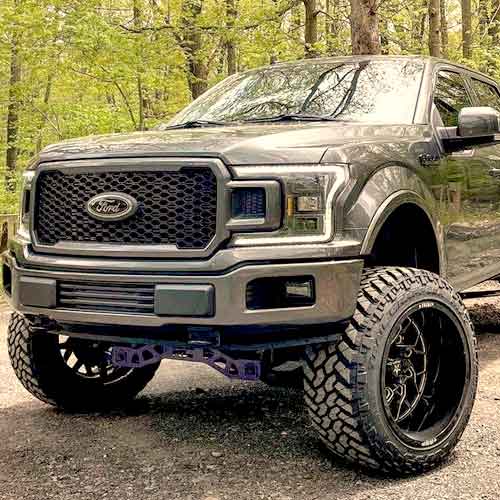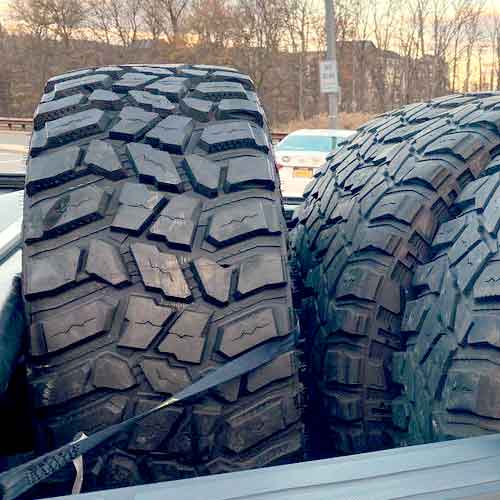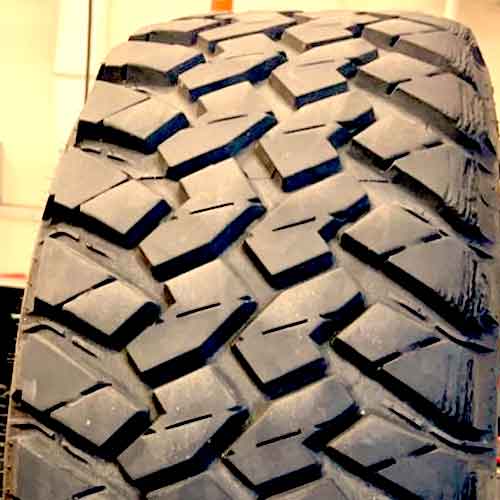If you’re looking to add an aggressive look to your vehicle, the Cooper Discoverer STT Pro and the Nitto Trail Grappler mud-terrain tires are options to consider. However, be aware that this type of style may have some drawbacks.

In my expert opinion as a tire engineer, the Nitto Trail Grappler provides grip on dry roads, but could use some wet traction overall. Whereas Cooper Discoverer STT Pro provides better efficacy there and off road it shines on rocks. If I talk about other performance areas, its complicated, as they both have some unique features and you can’t really put one better than the other.
Review Cooper STT Pro here.
Review Nitto Trail here.
Table of Contents
Tread Design
The Cooper Discoverer STT Pro is a highly specialized tire where its unique tread allows it to be great on various types of terrains, including smooth roads.

It’s tread basically consists of just 3 ribs (2 outer shoulder columns and 1 inner).
In the middle, you see a combination of 3 blocks with off-set edges, and zigzag siping.
And besides having reinforced foundations underneath, these lugs are also joined by outer surrounding blocks by multiple stone ejectors (running underneath). With this, the tire self cleans its tread, and at the same time, keeps its on road traction stable.
Coming to outer ribs, where the shoulder lugs are covering the majority of area, it’s no surprise to see how well this tire scoops out the dirt, mud and other debris, in all types of rugged terrains.
They make wider lateral grooves overall, filled with numerous stone ejectors, allowing this tire to yield a very efficient self-cleaning tread.
Moreover, on outer edges, these lugs are staggered and form thick sidewall lugs as well, and these further add to the overall “digging/scooping”effect.
Moving on towards Nitto Trail Grappler, you get a much simpler design.

It’s symmetric tread features 2 ribs in the middle and 2 outer shoulder ribs.
The inner columns have L shaped lugs, having full depth rectilinear siping and small notches.
While the outer ribs carry larger shoulder lugs with slightly thicker siping slits.
Together all these make 3 longitudinal channels connected to wider lateral tread voids of shoulder lugs.
And with powerful stone ejectors in between there, the tread gets to be pretty self-clean.
Compared to Cooper STT Pro, basically this tire is not just focusing on lateral evacuation, and keeping things balanced with multiple channels.
Internal Construction
Durability is mainly determined by internal construction, specifically the sidewalls, and sicne both tires offer 3 ply polyester cover to protect that, they are both meeting the durability criteria needed.
Though still as the Nitto Trail Grappler offers one extra cap ply in comparison, if you have to pick one, you can say this tire is slightly tougher, though it’s weigh also gets increased with it (which impacts some key areas, as you’ll find out ahead).
Sizes Info
The Nitto Trail Grappler comes with 53 total sizes in 15 to 26 inches. They have following specs.
- Speed Ratings: P or Q.
- Load Range: C up to F
- Weight Range: 61 and goes up to a whopping 116 pounds.
- Tread depth: 19/32″ to 21/32″.
The Cooper Discoverer STT Pro on the other side, offers 49 sizes, in 15 to 22 inches and they have following specs:
- Speed Ratings: Q.
- Load Ratings: C to F.
- Weight Range: 42 to 94 lbs.
- Tread Depth Range: 18 to 22/32″.
Wet Traction
Wet traction is not easy to achieve to mud-terrain tires, as it requires faster water cleaning.
This clearing of water is basically done by grooves and sipes, and although there is no deficiency of “grooves” in mud tires, they sure are very lacking in the siping department,
Sipes basically flex and create a vacuum so they can suck water particles in them, providing a micro level grip.
And both tires here neither have those sipes, nor they are flexible enough to allow the little bit of sipes that they do have to flex.
Dry Traction
When analyzing the dry traction of such aggressive tires, there are 2 things to keep in mind, I’ve made sub-headings of them both below.
Dry Handling
Handling depends on shoulder lugs, to be more specific, it depends on how much shoulder could meet with the road while turnings, as during cornering, they get to bear most of the tires weight.
And due to wider lateral spacing, the Cooper Discoverer STT Pro is not able to provide as much lateral traction, though it does not mean that the other tire is better, as Nitto Trail Grappler lacks with it’s weight which indirectly affects its steering response negatively.
Dry Grip
Dry grip, also known as directional grip is dependent on the tire’s footprint and tread composition and depth.
For the footprint, how much contact a tire makes with central lugs is considered (when rolling straight, the whole tires weight is more emphasized on the middle tread area).
So with more closeness of the central lugs on Nitto Trail Grappler, and a better streamlined placement of lugs, forming longitudinal ribs/tread voids, the tire gets to provide better grip with shorter stopping distances (which is how directional grip get calculated).
The Cooper Discoverer M/T on the other side, only has a single central rib and that has a lot more gaps in between as the tire’s orientation is more lateral, so it lacks slightly.
Tread and Fuel Usage
Fuel and tread are both affected by tires weight, composition and tread depth. Let’s see why.
With more weight, more force is applied on the lugs, and if the composition of those lugs are softer/stickier, they would resist to moving, and hence would consume more fuel.
Out of both tires, although the Nitto Trail Grappler, even with such balder structure is still somewhat less voided.
So that means Cooper STT Pro gets to push its lugs more towards the road.
But then again the tire is also weighing less, and both tires offer stiffer composition of lugs which by no means are “stickier” then one another.
So they both offers similar MPGs.
Same goes for the tread wear as well, the Nitto Trail Grappler although with heavier weight and less tread depth tends to burn off quickly, its overall tread life is similar to it’s competitor.
And Discoverer STT Pro with lateral grooves provide more biters.
Snow Performance
Both tires are although missing 3PMSF (3 peak mountain snowflake ratings), they still get to have M+S symbols, so they can still work on deeper terrains.
Though keep in mind that its straight up dangerous to take them on icy roads, and I would be very careful with them on roads as well.
But with scooping lugs, deeper “off-road” snow is handed in a better way, but still overall the Cooper STT Pro gets to score better as it yields superior “scooping” with it’s lateral tread voids and elongated lugs.
The Nitto Trial Grappler in comparison has a longitudinal orientation only, and it’s not able to throw back as much snow to create forward momentum.
Off Road Traction
Mud-terrain tires are designed to handle a variety of terrain types, including all off road, and not just mud, as their names suggest. Let’s see why.
Muddy Terrain
Mud is the toughest of all terrains, and so less aggressive tires get packed here very easily. That’s why “mud-terrain” tires exist which such balder structure.
And out of both tires here, you can really pick one, as each have their own unique abilities.
The Cooper STT pro basically does mud escaping capabilities, with it’s lateral grooves (formed by elongated shoulders). The tire’s asymmetric pattern basically offers a better pathway for mud to leave out, while it’s sharp biters in the middle cut through so mud can be broken down.
But that does not mean its a better mud tires, as you get to have equal traction with Nitto Trail Grappler as well.
You see, this tire provides better mud scoping. It’s dual sidewall lugs are thicker and this combined with its bulkier shoulder scoops, its tends to throw more mud backwards to produce forward moving momentum.
Rock Trails
Cooper Discoverer STT Pro is my go to tire when it comes to rocky terrains, that’s because this tire yields a best combination of lateral and longitudinal traction.
If you consider its tread again (by scrolling to its section), you’d note that the tire makes clear lateral grooves (forming a wave-like pattern), whereas at the same time you also see longitudinal grooves as well (formed by thick central running rib, with 3 unique blocks placement).
Moreover, the tire’s shoulder lugs and sidewall biters are also optimized for providing superior lateral traction and they create tremendous amount of bite with lowered air pressure.
The Nitto Trail Grappler is only better in terms of sideways traction, and it’s heavier weight is not so great with overall climbing, though it’s still good enough compared to other MT options out there.
Deep Sand
On sand you need to avoid as much digging as possible as that is the worst thing for traction.
And so with heavier weight the Nitto Trail Grappler lacks overall, and you really feel it on slopes.
The Cooper Discoverer STT Pro on the other side, provides softer edges and with comparatively lighter weight, it floats better.
Moreover, although the Nitto Trail offers good enough lugs on sidewalls, the one on Discoverer Pro still offers greater footprint, rendering it better here overall.
Takeaway Points
Out of both the Nitto Trail Grappler supplies superior dry grip, whereas the Cooper STT Pro is better with wet and snow traction.
And besides, that you can’t really tell which tire is better as it gets complicated with other performance sections.